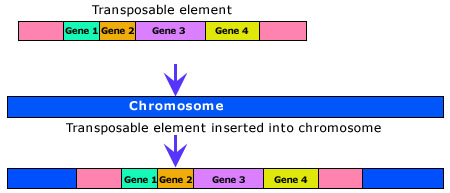Transposable genetic elements are segments of DNA that have the capacity to move from one location to another (i.e. jumping genes).
Properties of Transposable Genetic Elements
Random movement : Transposable genetic elements can move from any DNA molecule to any DNA molecule or even to another location on the same molecule. The movement is not totally random; there are preferred sites in a DNA molecule at which the transposable genetic element will insert.
Not capable of self replication
The transposable genetic elements do not exist autonomously (exception - some transposable phages) and thus, to be replicated they must be a part of some other replicon.
Transposition mediated by site-specific recombination : Transposition requires little or no homology between the current location and the new site. The transposition event is mediated by a transposase coded for the transposable genetic element. Recombination that does not require homology between the recombining molecules is called site-specific or illegitimate or non homologous recombination.

Transposition can be accompanied by duplication
In many instances transposition of the transposable genetic element results in removal of the element from the original site and insertion at a new site. However, in some cases the transposition event is accompanied by the duplication of the transposable genetic element. One copy remains at the original site and the other is transposed to the new site.
Importance of transposons:
Many antibiotic resistance genes are located on transposons. Since transposons can jump from one DNA molecule to another, these antibiotic resistance transposons are a major factor in the development of plasmids, which can confer multiple drug resistance on a bacterium harboring such a plasmid. These multiple drug resistance plasmids have become a major medical problem.